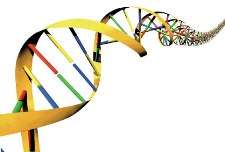May 16, 2011 feature
The next computer: your genes

(�鶹��ԺOrg.com) -- "Human beings are more or less like a computer," Jian-Jun Shu tells �鶹��ԺOrg.com. "We do computing work, and our DNA can be used in computing operations." Shu is a professor at the School of Mechanical and Aerospace Engineering at the Nanyang Technical University in Singapore. "For some problems, DNA-based computing could replace silicon-based computing, offering many advantages."
Shu has been working with his students, Qi-Wen Wang and Kian-Yan Yong, at Nanyang Technical University to propose a way that the manipulation of DNA strands could be used to solve certain types of problems. Their work has been published in �鶹��Ժical Review Letters: “DNA-Based Computing of Strategic Assignment Problems.”
The computations that the human body performs naturally are much faster than even the fastest silicon-based computer. On top of that, Shu points out, silicon is not very environmentally friendly. “There are also heat problems. DNA-based computing could be faster, friendlier for the environment, and eliminate some of the other problems that come with silicon.”
DNA-based computing could prove especially useful for strategic assignment problems. “Even with developments in silicon-based computing, there are some problems that take even the fastest computers months to solve,” Shu says. With DNA-based computing, massive parallel problems, combinatorial problems and AI solving problems could all be addressed with the possibility of greater efficiency.
“Silicon-based computing relies on a binary system,” Shu explains. “With DNA-based computing, you can do more than have ones and zeroes. DNA is made up of A, G, C, T, which gives it more range. DNA-based computing has the potential to deal with fuzzy data, going beyond digital data.”
Shu and his students manipulated strands of DNA at the strand level and at the test tube level. They found that they could fuse strands together, as well as cut them, and perform other operations that would affect the ability of the DNA to compute. In this model, DNA molecules are used to store information that can be used for computational purposes.
“We can join strands together, creating an addition operation, or we can divide by making the DNA smaller by denaturization,” Shu says. “We expect that more complex operations can be done as well.”
However, Shu points out that DNA-based computing is in the most basic of stages right now. “So far, there are a lot of human manipulations that must be done. We’d like to refine it so that there is less human interference. In silicon-based computing, we let the CPU do everything. We need to get to the point where we just need to provide a command and let the DNA do everything.” Cost is also an issue. “DNA right now is very costly and hard to commercialize.”
Another challenge with DNA-based computing is the display. It’s very difficult to display the results from DNA-based computing, since electronics have to be used. “We need to find the missing link between electronic speed, which slow, and DNA speed, which is fast – more like optical speed.”
Despite the challenges, Shu is optimistic. “We have made some progress, and we expect to continue making more progress. DNA is the future of computing.”
More information: Jian-Jun Shu, Qi-Wen Want, and Kian-Yan Tong, “DNA-Based Computing of Strategic Assignment Problems,” �鶹��Ժical Review Letters (2011). Available online:
Copyright 2011 �鶹��ԺOrg.com.
All rights reserved. This material may not be published, broadcast, rewritten or redistributed in whole or part without the express written permission of �鶹��ԺOrg.com.

















